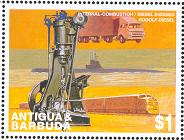|
Rudolf Diesel, 1858 - 1913
 The diesel engines of today are refined and improved versions of Rudolf Diesel`s original concept. They are often used in submarines, ships, locomotives, and large trucks and in electric generating plants. The diesel engines of today are refined and improved versions of Rudolf Diesel`s original concept. They are often used in submarines, ships, locomotives, and large trucks and in electric generating plants.
While on a boat trip to England in 1913 to discuss the possibility of converting British submarine fleet to diesel he disappeared. A few days later, on September 30, his body was found floating in the English Channel.
The English papers were full of stories of his assassination by French operatives who obviously didn’t want the British submarine fleet converted. The French fleet had already converted by 1905.
Rudolf Diesel was born in Paris, March 18, 1858. His parents were Bavarian immigrants. Rudolf Diesel was educated at Munich Polytechnic. After graduation he was employed as a refrigerator engineer. However, his true love lay in engine design.
Rudolf Diesel designed many heat engines, including a solar-powered air engine. In 1893, he published a paper describing an engine with combustion within a cylinder, the internal combustion engine. In 1894, he filed for a patent for his new invention, dubbed the diesel engine. Rudolf Diesel was almost killed by his engine when it exploded. However, his engine was the first that proved that fuel could be ignited without a spark. He operated his first successful engine in 1897.
In 1898, Rudolf Diesel was granted patent #608,845 for an "Internal Combustion Engine" the Diesel engine.
At Augsburg, on August 10, 1893, Rudolf Diesel`s prime model, a single 10-foot iron cylinder with a flywheel at its base, ran on its own power for the first time. Rudolf Diesel spent two more years making improvements and in 1896 demonstrated another model with the theoretical efficiency of 75 percent, in contrast to the ten percent efficiency of the steam engine.
By 1898, Rudolf Diesel was a millionaire. His engines were used to power pipelines, electric and water plants, automobiles and trucks, and marine craft, and soon after were used in mines, oil fields, factories, and transoceanic shipping.
How diesel engines work?
A diesel engine works by igniting the air-gas mixture without a spark. The heat that ignites the mixture comes from a temperature increased, caused by raising the pressure inside the combustion chamber of the engine. Diesel fuel is injected at the top of the stroke under great pressure so that it atomises into the combustion chamber, where it mixes with air at high temperature and pressure. The resulting mixture ignites and burns very rapidly. This contained explosion causes the gas in the chamber to expand, driving the piston down with considerable force and creating power in a vertical direction. The connecting rod transmits this motion to the crankshaft which is forced to turn, delivering rotary power at the output end of the crankshaft. Scavenging (pushing the exhausted gas-charge out of the cylinder, and drawing in a fresh draught of air) of the engine is done either by ports or valves.
A vital component of any diesel engine system is the governor, which limits the speed of the engine by controlling the rate of fuel delivery.
Back to History Index
 |
Antigua & Barbuda |
1998 |
Rudolf diesel,1858-1913, internal combustion engine and a submarine |
|